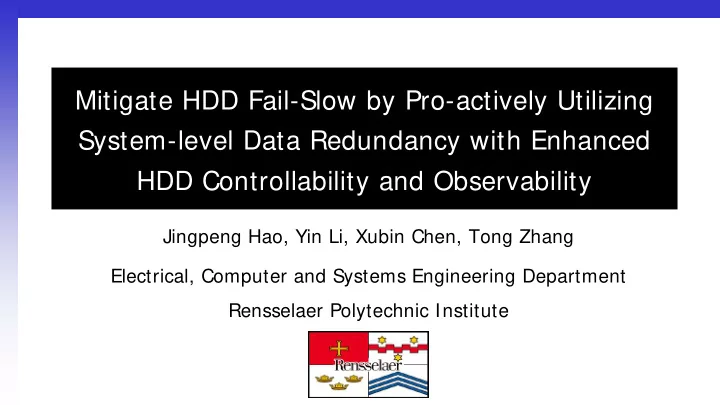

Mitigate HDD Fail-Slow by Pro-actively Utilizing System-level Data Redundancy with Enhanced HDD Controllability and Observability Jingpeng Hao, Yin Li, Xubin Chen, Tong Zhang Electrical, Computer and Systems Engineering Department Rensselaer Polytechnic Institute
HDD Fail-Slow The well-documented “fail-slow at the scale” problem: HDDs can occasionally operate at a speed much slower than their normal specs. Humidity Temperature Effect of fail-slow is amplified in large-scale Vibration systems (e.g., data centers). Environmental Abnormally High Variation Fail-Slow Intra-HDD Read Retry Rate Continuous Track Pitch Reduction How to most effectively mitigate HDD fail-slow in large-scale systems TDMR HAMR SMR 2
HDD Read Retry In case of sector read failure, repeat reading this sector with additional disk rotations until success (long delay) or time-out (data loss) Abundant system-level data redundancy in large-scale systems Distributed Erasure Coding RAI D RAI D RAI D RAI D . . . RAI D RAI D RAI D RAI D 3
Mitigate HDD Fail-Slow Complement HDD read retry with system-assisted data reconstruction Read retry System-assisted data A read request timeout reconstruction Fixed retry timeout limit Enhance the controllability of HDDs in terms of read retry Read retry System-assisted data A read request timeout reconstruction Controllable retry timeout limit OCP (open compute project) proposal: fail-fast read of data center HDDs Per-request controllable read retry timeout limit 4
Mitigate HDD Fail-Slow Enhance the controllability of HDDs in terms of read retry . . . Controllable retry timeout limit System-assisted data Intra-HDD retry reconstruction Shorter per-HDD read latency x Longer per-HDD read latency Less cross-HDD read traffic x More cross-HDD read traffic
Pro-active Design Approach 1. Normal mode: solely rely on intra-HDD read retry Fixed retry timeout limit 2. System-assisted mode: leverage system-assisted data reconstruction by reducing retry timeout limit or even eliminating retry Controllable retry timeout limit Normal Y Success? Finish Y mode Compare the Normal mode A read N request two modes better? System-assisted N mode
Pro-active Design Approach To maximize practical feasibility, we assume The simplest host-side HDD controllability: host can only turn-on/off HDD read retry on the per-request basis The simplest host-side HDD observability: host can only inquiry HDDs regarding read retry statistics via S.M.A.R.T. commands Use RAID as the test vehicle How to most effectively implement the system-assisted mode? How to improve the sector failure tolerance of the system-assisted mode? For each read request, how to decide which mode we should choose?
Pro-active Design Approach ? How to most effectively implement the system-assisted mode? Runtime variation among HDDs (e.g., sector failure rate, queue depth) A read request Operating system Software RAID controller Request Request removal removal
Pro-active Design Approach How to improve the sector failure tolerance of the system-assisted mode? Illustration of (a) conventional RAID and (b) proposed eRAID on 3 HDDs with m = 2 and k = 1.
Pro-active Design Approach For each read request, how to decide which mode we should start with? Y Normal Success? Finish Y mode A read Compare the Normal mode N request two modes better? System-assisted N mode A mathematical formulation framework Per-HDD request Per-HDD sector Per-HDD latency Request arrival queue depth failure statistics statistics statistics
Pro-active Design Approach An experimental platform to facilitate the research Request generation/scheduling/monitoring, RAID coding, failure injection . . . . . . . . . . . . To emulate intra-HDD read retry Increase the read request size to force additional disk rotations For example, assume 1.2MB per track convert a 4kB read request to a 3.6MB read request to mimic the read retry with 3 disk rotations
Experiments A server with dual-socket Intel Xeon E5-2630 2.2GHz CPUs (10 cores per socket) and 64GB DRAM Six 2TB 7200rpm SATA HDDs form a RAID-5 with the stripe size of 8kB Total 192 user-space threads to concurrently dispatch read requests to all the six HDDs Assume 3 rotations or 5 rotations per read retry
Experiments Impact of HDD fail-slow on the average and tail read latency Read request size Retry rate Rotations per 8kB 24kB 40kB retry 0 16ms 41ms 107ms Average read 1% 18ms 48ms 221ms 3 latency 2% 19ms 64ms 269ms 1% 18ms 56ms 284ms 5 2% 22ms 90ms 553ms Read request size Retry rate Rotations per 8kB 24kB 40kB retry 99% tail read 0 43ms 169ms 832ms 1% 63ms 236ms 1,712ms latency 3 2% 68ms 512ms 2,190ms 1% 81ms 243ms 2,513ms 5 2% 98ms 530ms 3,336ms
Experiments Implementation of system-assisted mode 1. Proposed: Pro-active data reconstruction w. adaptive request removal 2. Pro-active data reconstruction (without adaptive request removal) 3. Reactive data reconstruction (without adaptive request removal) Request size: 24kB Request size: 40kB Request size: 80kB
Experiments Implementation of system-assisted mode 1. Proposed: Pro-active data reconstruction w. adaptive request removal 2. Pro-active data reconstruction (without adaptive request removal) 3. Reactive data reconstruction (without adaptive request removal) Request size: 24kB Request size: 40kB Request size: 80kB
Experiments Read-only workloads with read request size 8kB~ 80kB Mean of request arrival time: 8ms All the HDDs are subject to the same sector failure rate
Experiments Read-only workloads with read request size 8kB~ 80kB Mean of request arrival time: 8ms Only one HDD is subject to the high sector failure rate
Experiments Measured average and 99- percentile read latency under six different traces. All the HDDs are subject to the high sector failure rate.
Experiments Measured average and 99- percentile read latency under six different traces. Only one HDD is subject to the high sector failure rate.
Conclusion and Future Work Conclusion: A strategy that can most effectively implement the system-assisted mode. A design technique to enhance existing redundancy coding schemes. A mathematical framework to quantitatively formulate the impact of the system-assisted mode on the overall system read latency performance. Experiments in the context of a RAID-5 system consisting of six 2TB 7200rpm SATA HDDs. Future Work: Integration with SMR HDDs (in particular host-managed SMR HDDs). 20
Recommend
More recommend